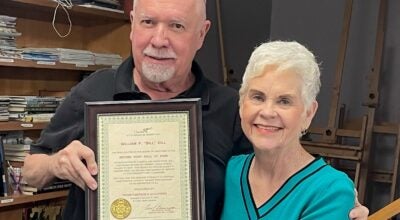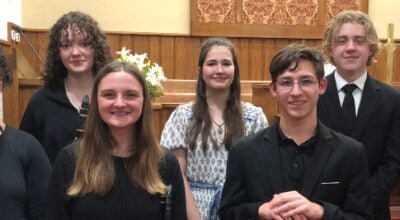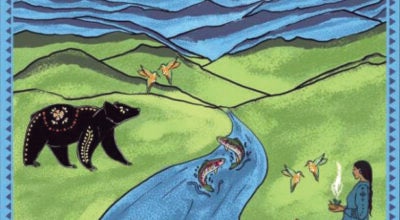Chris Bartol photographing the community
Published 3:00 am Friday, February 20, 2009
I&squo;ve seen some of Chris&squo; work helping with head shots for Steel Magnolias or letting the Bulletin run some of his shots of Cathy Smith Bowers for her article. Since I first walked into his studio for a passport photo, he&squo;s now moved slightly off the beaten path to a smaller studio at 28 Oak Street in the alley behind his former studio on Trade Street. I stopped in to visit with him about art as business. How long have you been in photography business here? I moved back here in 1986. I am from Tryon, was raised here. Unfortunately, Mom was in New Jersey when I popped out in 1941. Dad was in the service, so I was born in Orange, New Jersey. Mom is from here and is the matriarch. I moved away, interested in photography a lot during that time. Growing up I had a brownie camera. My dad had a little dark room, and I was always interested in it I guess. Did your dad show you how to use the dark room? Well, yeah a little bit. I learned how to print and, when I was about 12 or 13, he gave me a camera, a real 35mm camera. I knew how to process my own film and that was the beginning of it. I was in the Citadel. I found a business card of the photographer that they hired to do the yearbook and I wrote him a note. I said, &dquo;How does one get started in photography?&dquo; He was very kind to write back. He said, &dquo;There&squo;s three ways. You could work for someone who&squo;s a photographer, but you&squo;re only going to learn what he can teach you unless you&squo;re really aggressive at it.&dquo; Then correspondence schools were really big, because it was in the 1960s. He said, &dquo;You could take a correspondence course, but if you don&squo;t have equipment, or don&squo;t have access to equipment, it&squo;s very difficult. What I recommend is if you&squo;re really interested, you go to a photo school.&dquo; He rattled off RIT which is Rochester Institute. He said, &dquo;Brooks Institute in California is really up and coming.&dquo; So, I wrote to Brooks Institute and they accepted me. Long story short, the end of my junior year, which I still regret, I resigned, got married, and moved to the west coast. I went to Brooks Institute and graduated with honors. I worked my way back to the eastern part of the country working in Albuquerque, New Mexico and Springfield, Illinois, and made it back to Philadelphia. I worked there for a while. There was a job opening in the Alderman Company in High Point, which was at the time, the world&squo;s largest still commercial photography studio, four and a half acres under one roof. It was a dream come true to work for them. I did home furnishings and small products, and worked for them quite a lot. The owner of the studio in Philadelphia passed away, and two or three years after I started at Alderman they asked me to come back to run the studio. It was a difficult decision because it was more administration than it was photography. A step up, but was it in the right direction? I don&squo;t know. Did you take it? I took it. The son of the owner of the studio took over the business, but for whatever reason we were losing ground. Other major studios were in the area in Philadelphia. It was liquidated and fortunately I&squo;d left Alderman with a good taste in their mouth and I was asked to come back. I thought about it, and went back to Alderman and worked there until I decided to go work for an advertising agency that was a lot more creative for me. My dad passed away in 1976, Mom was still alive, and then end of 1985 I just kept making the decision to come back to Tryon. End of 1985, winter of 1986 I was here and had a studio where the old ice plant used to be on Highway 176 that&squo;s now an antique store. I had to make a decision. I wanted to be able to process my own film, do my own color work and slides, being in the commercial end of it. There were not any one-hour labs within thirty miles of Tryon. I made the decision to bite the bullet and at a space in Columbus I opened up a business called PhotoWorks, which was a division of Bartol Photography. I was thinking that I could get it up and running and then go do my commercial work. It took so much time and energy to maintain the equipment. I bought equipment at just the wrong time, because digital was on the horizon, but I didn&squo;t see it yet. I spent close to $85,000 on equipment. Oh my goodness! Pretty sophisticated stuff, I was able to do 8×10, 11×14, composite printing, and print packages. Revco was in Columbus at the time and when CVS bought them out, the first thing they did was put in a lab. I lost about 35% of my business overnight, but I got it back because they could see quality. I gutted it out for as long as I could, but I realized I was going to have to update, get new equipment or transform my equipment. I got out of that business. PhotoWorks was no longer. I moved back to Tryon and opened up Bartol photography. Concentrating on some weddings, but mostly executive portraits and family portraits, which is what I really loved. Unfortunately, four years after I moved back I really wasn&squo;t making money. I found out I&squo;d been embezzled for four years. Oh no. Anyway, I&squo;m still getting out from under that. It&squo;s been two and a half years. That&squo;s another story. It was a difficult lesson to learn, because I was trusting. I learned a very tough lesson. So, you went from thinking about photography as a kid that it was fun to do, to actually pursuing it all the way to the big corporate business end of it. I really enjoyed it. I was working for &dquo;the man.&dquo; I didn&squo;t have to make decisions about business stuff. It was great. Believe it or not, I would have bet that digital would not have taken over film in my lifetime. What changed your mind? Mountain Traditions “product shot” photo composition by Chris Bartol I was heading up to Asheville, or Hendersonville, and the got a call saying, &dquo;We just got a phone call from an electronics firm in Landrum. Can we take pictures of small parts?&dquo; I said, &dquo;Sure.&dquo; She said, &dquo;Well they want it by 3:30 p.m. or something.&dquo; I said, &dquo;I&squo;ll tell you what,&dquo; my gears are turning, &dquo;if you tell them I can have it for them by 10:30 in the morning, I can do it.&dquo; She said, &dquo;Well, they&squo;ll call you back.&dquo; I figured I lost that one. I got back about 2:30 p.m. and she said, &dquo;Someone&squo;s coming in from Landrum with a bunch of parts for you to photograph.&dquo; Yeah! I didn&squo;t have a digital camera. The biggest thing on my computer was a zip drive. You know Chuck Hearon? Yes. Chuck&squo;s a dear friend of mine. Wonderful guy and he jumped into digital. I called him and said, &dquo;Chuck, will you let me use your digital camera?&dquo; He said, &dquo;Sure.&dquo; He brought his camera over. He was thrilled with how I could light something like this. I was thrilled with seeing this stuff on the screen. I put it all together, and I think I had Photoshop &dquo;one&dquo; and I worked with it, put it on a zip drive, took it down there at 10:30 a.m. They were thrilled. 12:30 p.m. I get a phone call, &dquo;Love the shots, but one of the parts in shot A, which is not your fault, needs to be in shot C.&dquo; Chuck didn&squo;t leave his camera with me, but they&squo;re on my computer. I got on the computer, took the part moved it over here, covered it up, rearranged that, made another zip drive, took it over there. I said, &dquo;I am sold.&dquo; I am psyched. I am re-energized with photography because I thought I was going to be selling plumbing supplies at Home Depot. Stuff was passing me by, I didn&squo;t understand computers. Well, photography hasn&squo;t changed. Had you used Photoshop much at that point? No. It was just something you were able to figure out? It took me a while, but now I
&squo;m just zipping through stuff. I don&squo;t know much, but I&squo;m learning. My learning curve is huge. But, you&squo;re doing it every day? My point is this: photography hasn&squo;t changed except our tools. How I envision something, how I perceive it, how I compose it in my mind, how I digitalize it ‐ nothing&squo;s changed. I still do that. This camera&squo;s a different tool. It does things generally the same, but the output is now digital instead of film based. With that in mind I&squo;ve been totally re-energized. Now I&squo;m just turning 67. Carol&squo;s retiring from the college. I&squo;m going, &dquo;I need to slow down a little bit.&dquo; I can&squo;t really because I&squo;m still dealing with&ellip; Recovering? Recovering. However, I love what I&squo;m doing. Now Bartol Photography is a business. I wanted to create something different, or something more. I&squo;m getting more requests for copy and restoration work. People are realizing their scrapbooks, photo albums, or boxes of slides are items they want to be able to pass on. I just put an ad in the Bulletin for ImagePro. One of the things is that the work you bring in here doesn&squo;t leave the studio. If you take it to CVS or some other lab, they&squo;re going to send it off. It&squo;s passed hand to hand? You can&squo;t possibly let these things go. I call it ImagePro, because I wanted to be part of Bartol Photography, but I didn&squo;t want my name on it, because I wanted it to be seen as a new outfit in town that does new work. My next door neighbor, Jim Gross, sells a product. All the stuff you see in here is his product. He&squo;s helping pay my rent and it&squo;s a good hand in hand thing right now. People are having difficulty with the whole economy being what it is. A lot of stuff that I do is discretionary money. Everyone is pulling back and if I can let people know specifically that you can get this kind of work done economically and with quality, that&squo;s the way to go. I had a client come in yesterday, and she said nobody that she&squo;s been able to find, can do slide copies. This is a 35mm slide in a 2×2 bound, and that&squo;s a Minox, 8mm film. Let me just show you, this is from one of the jobs I&squo;m doing. That&squo;s the slide. Oh, wow that&squo;s amazing. It looks like that photo was just taken yesterday. Dade photo scan before adjustments by Chris Bartol Dade photo scan after restoration adjustments by Chris Bartol This one here is before and after and it&squo;s quick. I have a set up in here where, as fast as I can put the slide in front of the camera and click it, I&squo;m actually taking a picture of it. That&squo;s my scan. That&squo;s a three megabyte file. Of course I&squo;ve got to come back here and play with them, but I did 175 slides for a client right before Christmas in less than a week onto CD. They&squo;re thrilled. So you could take someone&squo;s whole set of vacation photos from they&squo;re honeymoon and they could put that onto a CD for their grandchildren? I&squo;m also getting to the point to get started editing and applying music. I did 99 images from an album for a gal of her mother, whom I knew as I was growing up. The pictures were circa 1939-43. Well she absolutely loved the images. Her grandson looked at it and said, &dquo;Mom I play with iTunes.&dquo; They downloaded period music, big bands, and paid 99 cents per song and put them on a DVD and everyone went bananas. I didn&squo;t think about music, I wasn&squo;t asked about music, it didn&squo;t occur to me. This is something that will be involved with ImagePro that will be just a cut above I hope. It&squo;s like putting music on at a family party and the images just run in the background on the screen. We had a double family reunion, the Bartols and the Calhouns. The Calhouns used to live here, Mom and Dad and Al and Emlia were the best of friends. All the kids were together, us four kids and their four kids. My sister Mimi said, &dquo;You know, we&squo;ve got all these images, all these pictures, all these slides that Dad took, and all our memories of growing up. We haven&squo;t seen these people in twenty five years. We need to have a reunion.&dquo; So, we did. Mimi and I scanned 1,500 images. We edited down to 400 and something. We had them on a computer disc and they played as a slide show during the parties. It was great. It is neat how there are different ways of using those photos now. They&squo;re not just being stuck in an album and put on a shelf anymore. I don&squo;t think I&squo;m that much of a cut above what&squo;s going on, however I&squo;m trying to find my niche. Something that I do here or at home, available by appointment only, still service oriented. I want to be able to provide a service at least for a while longer. I&squo;ve done a lot of work for civic organizations, for their golf tournaments. I will take a picture of all the teams before they start, but when they come back after playing 18 holes for the awards everybody has a picture. Now what&squo;s that garnered me I don&squo;t know, but at least its good will. I&squo;ve had people come to me and say, &dquo;I&squo;ve got five years of your pictures on my refrigerator. Do you have a different lens or something? I&squo;m getting older.&dquo; Unless you&squo;re in school as a teacher or student and getting pictures taken every year, most people don&squo;t stop to pose for a shot on a regular basis. When I was in Columbus, on Halloween we had a stroll and I would have a set up in the street. You could come in, in costume, and get your picture taken. Then three or four days later I would have them all on display and you&squo;d come in and they were yours to take. People would come in and say, &dquo;Where&squo;s my picture? Oh, there it is,&dquo; and they walk out. One guy said it was really fun to see his kids&squo; pictures on the refrigerator after four or five years as they changed. I have to stop giving everything away, but I still want to provide a service. Stay tuned for a continuation of our conversation where Chris explains the changes in the technology of photography and how he is reapplying his skills to meet the demands of the digital world. You can also reach Chris Bartol at www.bartolphotography.com or by calling 828-859-0497.





